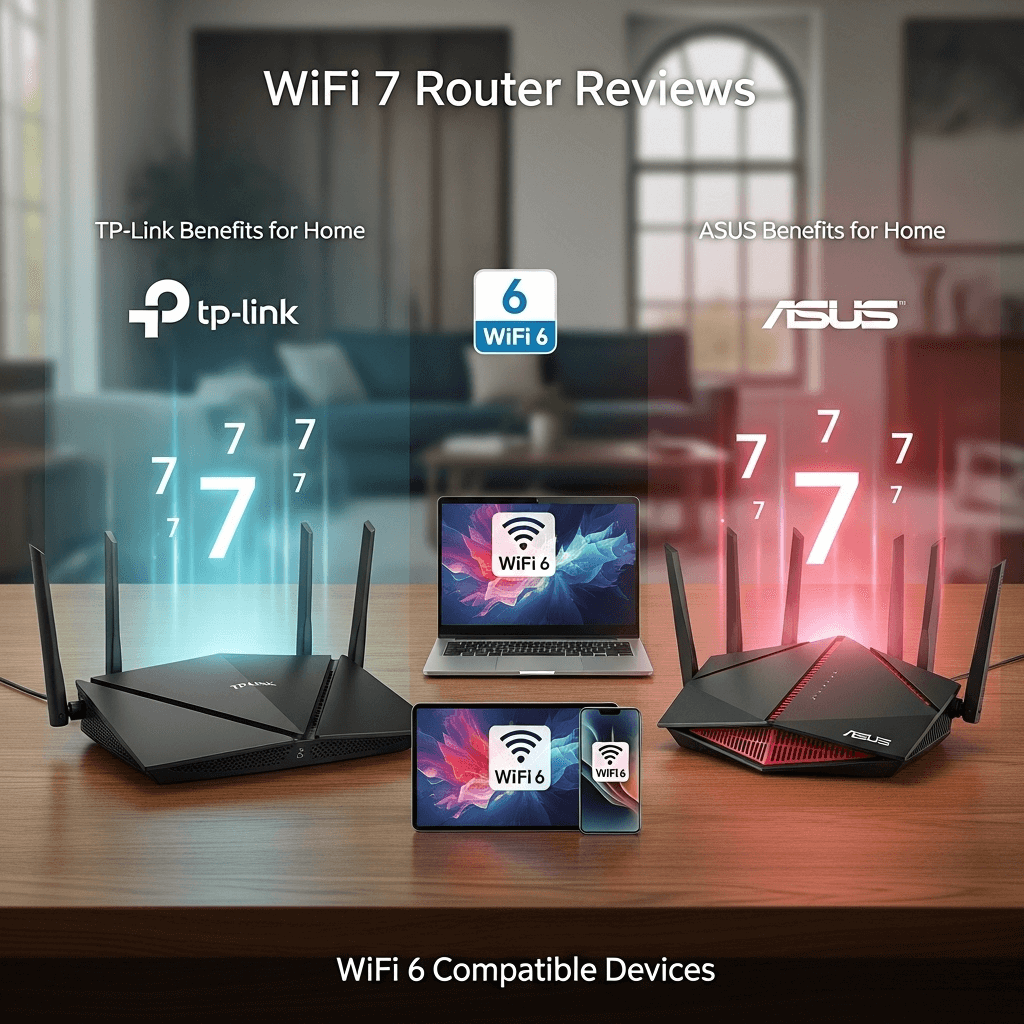The Ultimate Wi-Fi 7 Router Guide (2025): Worth Upgrading From Wi-Fi 6? TP-Link & ASUS Reviews

Welcome to the bleeding edge of wireless connectivity. In 2025, the digital landscape of our homes is more demanding than ever. We’re juggling 8K streaming, competitive online gaming, AR/VR experiences, and a constellation of smart devices, all hungry for bandwidth. The conversation is no longer just about speed; it’s about capacity, stability, and future-proofing your network.
This brings us to the ultimate question for any tech-savvy homeowner: Is it finally time to upgrade to a Wi-Fi 7 router? Or is a mature, more affordable Wi-Fi 6 or Wi-Fi 6E device still the smarter choice?
In this definitive guide, we will break down everything you need to know. We’ll explore the monumental leap that is Wi-Fi 7, compare it directly against its predecessor, review top models from giants like TP-Link and ASUS, and help you find the best value for your home, whether you’re shopping for a powerhouse on Amazon or a cheap but reliable workhorse.
What is Wi-Fi 7 (802.11be)? The Next-Gen Revolution Explained
Before we compare, let’s understand what makes Wi-Fi 7 (officially known as IEEE 802.11be) so revolutionary. It’s not just an incremental update; it’s a fundamental redesign built for the high-bandwidth, low-latency demands of the modern era. Think of Wi-Fi 6 as widening the highway; Wi-Fi 7 not only widens it but also adds multiple decks and intelligent traffic management.
Here are its game-changing core technologies:
- 320 MHz Ultra-Wide Channels: Wi-Fi 6E introduced the 6 GHz band, but Wi-Fi 7 doubles the channel width within it from 160 MHz to a massive 320 MHz. The simple analogy: This is like doubling the number of lanes on a data superhighway, allowing for a monumental increase in simultaneous data throughput. This is the primary driver behind Wi-Fi 7’s headline-grabbing speed claims.
- Multi-Link Operation (MLO): This is arguably the most significant real-world improvement. MLO allows a single device (like your smartphone or laptop) to connect to the router across multiple frequency bands (e.g., 5 GHz and 6 GHz) simultaneously. This aggregation provides faster speeds, drastically lower latency, and incredible reliability. If one band experiences interference, your connection seamlessly continues on the other.
- 4K-QAM (Quadrature Amplitude Modulation): This technology allows for more data to be packed into each signal transmission. Compared to the 1024-QAM of Wi-Fi 6, 4K-QAM results in a theoretical 20% speed boost. Think of it as fitting more parcels into the same delivery truck.
- Preamble Puncturing: This clever feature lets a router use a portion of a channel even if part of it is occupied by an older, slower device. It “punctures out” the interference, ensuring the rest of the wide channel remains usable, dramatically improving efficiency in congested environments.
Wi-Fi 7 vs. Wi-Fi 6/6E: A Head-to-Head Showdown
Let’s put the specs side-by-side to see the raw power difference. While Wi-Fi 6 was a huge leap over Wi-Fi 5, Wi-Fi 7 is on another level entirely.
| Feature | Wi-Fi 6 / Wi-Fi 6E (802.11ax) | Wi-Fi 7 (802.11be) |
|---|---|---|
| Theoretical Max Speed | 9.6 Gbps | 46 Gbps |
| Frequency Bands | 2.4 GHz, 5 GHz, (6 GHz for Wi-Fi 6E) | 2.4 GHz, 5 GHz, 6 GHz |
| Max Channel Width | 160 MHz | 320 MHz |
| Modulation | 1024-QAM OFDMA | 4096-QAM OFDMA |
| Key Technology | OFDMA, MU-MIMO | Multi-Link Operation (MLO), Preamble Puncturing |
| Latency | Good (10-20ms) | Ultra-Low (sub-5ms) |
What This Means for You: The numbers are impressive, but the real-world benefits are what matter. A Wi-Fi 7 network can deliver a near-wired experience, wirelessly. For gamers, this means latency that rivals an Ethernet cable. For households with dozens of devices, it means no more buffering or slowdowns, even when everyone is online. For content creators, it means transferring massive 8K video files in seconds, not minutes.
The Big Question: Do You *Actually* Need a Wi-Fi 7 Router in 2025?
This is where an honest assessment of your needs is crucial. A powerful router is only as good as the devices and internet plan connected to it.
Yes, Upgrade to Wi-Fi 7 Now If…
- You Have a Multi-Gig Internet Plan: If you’re paying for a 2.5 Gbps, 5 Gbps, or even 10 Gbps fiber connection, a Wi-Fi 6 router is a bottleneck. Only Wi-Fi 7, with its 10-Gigabit WAN/LAN ports and massive wireless throughput, can let you truly experience those speeds across your home.
- You’re a Hardcore Gamer or VR Enthusiast: The ultra-low latency provided by MLO is a game-changer for competitive online gaming and untethered, high-fidelity VR streaming. The stability and speed are unmatched.
- You Live in a “Smart Home” of the Future: You have dozens of IoT devices, multiple 4K/8K smart TVs, high-end laptops, and new Wi-Fi 7 enabled smartphones (like the latest iPhone and Samsung Galaxy models of 2025). Your network is dense and demanding.
- You’re a Content Creator or Professional: Regularly moving gigabytes of data between a NAS (Network Attached Storage) and your workstation? Wi-Fi 7 will save you a tremendous amount of time.
Hold On, Wi-Fi 6/6E is Still Perfect If…
- Your Internet Speed is 1 Gbps or Less: The vast majority of users fall into this category. A good Wi-Fi 6 or 6E router can easily handle a Gigabit connection and deliver it reliably to your devices.
- Your Primary Use is Mainstream: You mostly stream in HD/4K, browse the web, and have a moderate number of smart devices (15-25). Wi-Fi 6 is more than capable of handling this load without breaking a sweat.
- Budget is Your Main Concern: In 2025, Wi-Fi 6 routers offer incredible value for money. You can get a high-performance router or a capable mesh system for a fraction of the price of a new Wi-Fi 7 model.
- You Don’t Own Any Wi-Fi 7 Devices Yet: While Wi-Fi 7 routers are fully backward compatible with Wi-Fi 6 and older devices, you won’t get the key benefits like MLO or 320 MHz channels until you have a compatible client device.
2025’s Best Wi-Fi 7 Router Reviews: TP-Link vs. ASUS
TP-Link and ASUS continue to dominate the consumer networking space, and their Wi-Fi 7 offerings are a showcase of power and innovation. Here are our top picks for different needs and budgets.
TP-Link: Masters of Performance and Value
TP-Link has consistently delivered powerful hardware, often at very competitive price points. Their Archer and Deco lines are stronger than ever in the Wi-Fi 7 era.
1. The All-Rounder Beast: TP-Link Archer BE900
This router is a statement piece. With its futuristic design and front-facing LED screen that can display network stats or even a weather widget, it’s built to impress. But the beauty is more than skin deep.
- Pros: Quad-band BE24000 speeds, dual 10G ports, robust MLO implementation, extremely user-friendly Tether app for setup.
- Cons: Premium price tag, physically large.
- Best For: The power user who wants top-tier performance without a complex setup.
- Check Price on Amazon
2. The Mesh Marvel: TP-Link Deco BE85
For large homes where coverage is as important as speed, the Deco BE85 mesh system is a leading choice. It brings the full power of Wi-Fi 7 to every corner of your house, eliminating dead zones for good.
- Pros: Whole-home Wi-Fi 7 coverage, dedicated wireless backhaul using MLO, easy to expand, sleek and unobtrusive design.
- Cons: Less granular control than a standalone ASUS router.
- Best For: Owners of large or multi-story homes who demand seamless, high-speed connectivity everywhere.
- Check Price on Amazon
ASUS: The Choice of Gamers and Tinkerers
ASUS, particularly with its Republic of Gamers (ROG) line, caters to enthusiasts who love to tweak every setting for maximum performance. Their software is packed with advanced features.
1. The Gaming King: ASUS ROG Rapture GT-BE98 Pro
If your primary goal is to have the absolute lowest ping and zero lag in online games, this is your weapon. The GT-BE98 Pro is unapologetically built for gamers, with dedicated gaming ports and AI-driven traffic prioritization.
- Pros: Aggressive and effective QoS for gaming, unparalleled customization options in the firmware, extreme speeds, and robust hardware.
- Cons: The most expensive option, and the interface can be intimidating for novices.
- Best For: Competitive gamers and tech enthusiasts who want ultimate control over their network.
- Check Price on Amazon
2. The Sensible Powerhouse: ASUS RT-BE88U
Striking a balance between the extreme ROG line and mainstream needs, the RT-BE88U offers fantastic Wi-Fi 7 performance and multiple high-speed ports (including 10G) without the “gamer” aesthetic and price tag.
- Pros: Excellent performance, multiple 2.5G ports for a high-speed wired network, AiMesh compatibility for building a future mesh network, lifetime free security suite.
- Cons: Still a premium investment compared to Wi-Fi 6.
- Best For: The “prosumer” who needs a powerful, reliable router for a demanding home office and heavy streaming.
- Check Price on Amazon
Smart Shopper’s Guide: Finding “Cheap” Wi-Fi 7 & High-Value Wi-Fi 6
The word “cheap” is relative when discussing brand-new technology. For Wi-Fi 7, it’s about finding the best value. However, the best “cheap” router for most people in 2025 is likely still a fantastic Wi-Fi 6 or 6E model.
Tips for Buying Wi-Fi 7 on a Budget:
- Look for Entry-Level Models: Brands are now releasing more affordable Wi-Fi 7 routers, like the TP-Link Archer BE250 or ASUS TUF Gaming BE3600. They might lack 10G ports or have lower total throughput, but they still provide the core Wi-Fi 7 benefits for less.
- Don’t Overbuy for Your Plan: If you have a 1 Gbps internet plan, a BE19000-class router is overkill. A lower-spec’d Wi-Fi 7 router will still provide MLO and future-proofing.
- Check Amazon Warehouse Deals: Look for open-box or refurbished models from reputable sellers for significant discounts.
The True Budget King: Why Wi-Fi 6 is Still a Great Buy
By 2025, the Wi-Fi 6 ecosystem is incredibly mature. The prices have dropped, the firmware is stable, and the performance is phenomenal for 90% of households. You can find amazing deals:
- The Workhorse: TP-Link Archer AX73. Offers fantastic Wi-Fi 6 speeds and capacity for a very reasonable price.
- The Gamer’s Choice: ASUS RT-AX86U. A former flagship, now available at a mid-range price, it offers a mobile gaming mode and a 2.5G port.
The Final Verdict: To Upgrade or Not to Upgrade?
Making the right choice comes down to a simple flowchart of your personal needs:
Upgrade to Wi-Fi 7 if: You have a >1Gbps internet plan + you are a serious gamer/VR user/content creator + you own or plan to buy Wi-Fi 7 devices this year. For you, the investment is not just justified; it’s necessary to unlock the full potential of your digital life. The TP-Link Deco BE85 for whole-home coverage or the ASUS RT-BE88U for powerhouse performance are your best starting points.
Stick with Wi-Fi 6/6E if: Your internet is 1Gbps or slower + your main activities are streaming and browsing + budget and value are your top priorities. A top-tier Wi-Fi 6 router will serve you flawlessly and save you hundreds of dollars. It remains the most sensible, cost-effective choice for the vast majority of homes in 2025.
The future is undeniably wireless, and Wi-Fi 7 is its current standard-bearer. Whether you leap today or wait for tomorrow, one thing is certain: our connection to the digital world is only getting faster, smarter, and more seamless.




